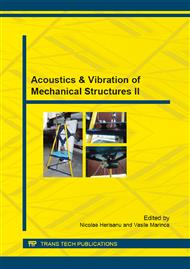[1]
European Commission, Research for a quieter Europe in 2020., sep. 2007., http: /www. transport-research. info/Upload/Documents/201206/20120611_125332_99759_20070927-CALM2-SPU-Sep07-final. pdf.
Google Scholar
[2]
DIRECTIVE 2002/49/EC OF THE EUROPEAN PARLIAMENT AND OF THE COUNCIL , Official Journal of the European Communities, http: /eur-lex. europa. eu/legal-content/EN/TXT/?uri=CELEX: 32002L0049.
Google Scholar
[3]
C. Malcolm, Handbook of Noise and Vibration control, John Wiley and Sons, New Jersey, (2007).
Google Scholar
[4]
Marshall Day Acoustics, INSUL, Sound Insulation Prediction Software, http: /www. insul. co. nz.
Google Scholar
[5]
B. Rasmussen, Sound insulation between dwellings – Requirements in building regulations in Europe, Applied Acoustics, 71: 2010. pp.373-385.
DOI: 10.1016/j.apacoust.2009.08.011
Google Scholar
[6]
E. Mommertz, Acoustics and Sound Insulation, Aumuller Druck, Regensburg, 2009. p.114.
Google Scholar
[7]
J. Đilas, Traffic noise action planning in agglomerations reduction potentials based on German good practice example, 23rd national Conference and 4th International Conference Noise and Vibration, Niš. (2012).
Google Scholar
[8]
G. Oral, A. Yener, N. Bayazit, Building envelope design with the objective to ensure thermal, visual and acoustic comfort conditions, Building and Environment, 39, p.281 – 287, (2004).
DOI: 10.1016/s0360-1323(03)00141-0
Google Scholar
[9]
V. Hongisto, M. Makila, M. Suokas, Satisfaction with sound insulation in residential dwellings - The effect of wall construction, Building and Environment, 85, pp.309-320, (2015).
DOI: 10.1016/j.buildenv.2014.12.010
Google Scholar
[10]
Continuous noise monitoring NMT1 – Daily report, Location: Intersection of Generala Milojka Lešjanina street and Kneginje Milice street, available at: http: /www. znrfak. ni. ac. rs/BVLab-KMB/KMB-NMT1-Dnevni_izvestaj. html.
Google Scholar
[11]
Continuous noise monitoring NMT2 – Daily report, Location: Dwelling unit façade at Knjaževačka 94 street, available at: http: /www. znrfak. ni. ac. rs/BVLab-KMB/KMB-NMT2-Dnevni_izvestaj. html.
Google Scholar
[12]
S. Kurra, L. Dal. Sound insulation design by using noise maps, Building and Environment, 49, pp.291-301, (2012).
DOI: 10.1016/j.buildenv.2011.07.006
Google Scholar
[13]
C. Buratti, L. Barelli, E. Moretti, Wooden windows: Sound insulation evaluation by means of artificial neural networks, Applied Acoustics, 74, pp.740-745, (2013).
DOI: 10.1016/j.apacoust.2012.12.001
Google Scholar


